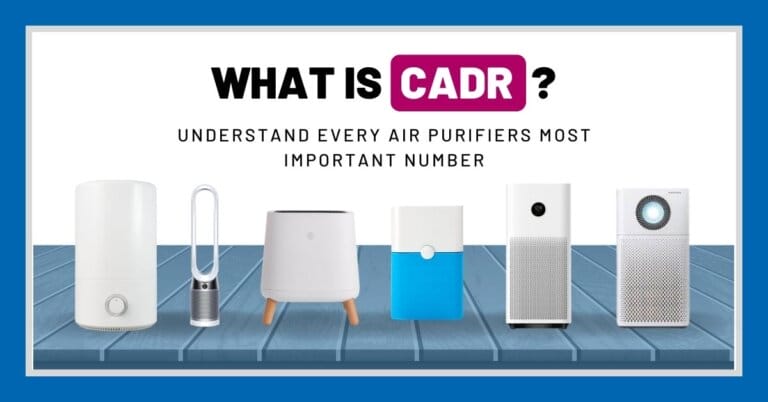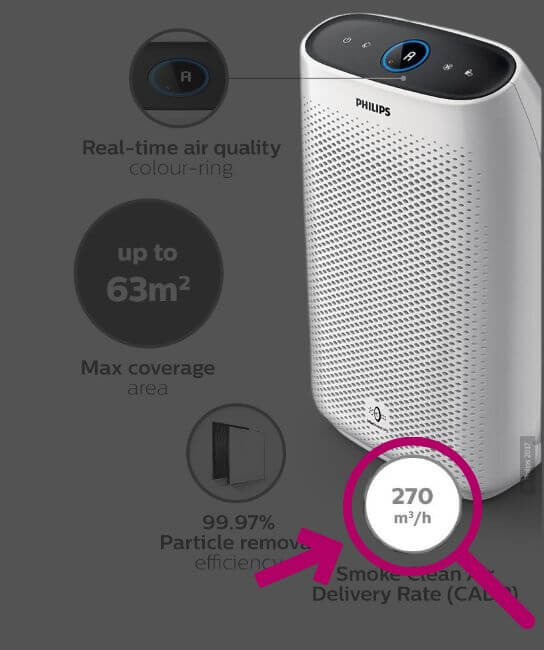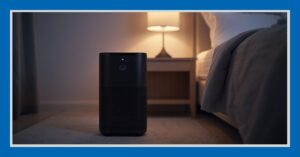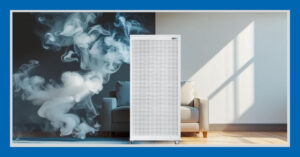
Air Purifiers: What Is the CADR Rating?
by Karl von Luckwald / January 2, 2024
Understanding CADR (Clean Air Delivery Rate) is crucial to choosing the right air purifier for your needs.
In this article, I’ll break down the concept of CADR, explain its importance, and clarify why it’s worth taking it more seriously than Airflow. Let’s dive in!
What is the CADR rating?
Let me guess: You are probably deep into air purifier research and puzzled by the meaning of CADR ratings.
CADR stands for Clean Air Delivery Rate.
In simple terms, it measures an air purifier’s ability to filter out pollutants such as dust, pollen, and smoke.
The higher the CADR number the stronger the air purifier. It’s that simple.
It gives you an idea of how effectively and fast an air cleaner can purify the air in a given space.
CADR (Clean Air Delivery Rate) is a key measure of how quickly and effectively the purifier cleans the air in a space. The higher the number, the stronger the air purifier.
Why CADR Matters When Choosing Air Purifiers
The most crucial factor to consider when buying an air purifier is room size.
You need an air cleaner that keeps up with your space. Otherwise, the air in your bedroom will remain dirty.
Large rooms need stronger air purifiers. Or at least more of them.
Many brands “do us a favor” and label their machines with square meter specifications. This is well meant, but it’s not reliable.
Soon you will learn why.
Instead, check the data in the spec sheet and look out for the CADR.
The CADR rating is given in cubic meters per hour (m³/hr) or square feet per minute (sqft/min).
This number will give you the most accurate information on how effective an air purifier is.
CADR is either measured in cubic meters per hour (m³/hr) or square feet per minute (sqft/min).
Measuring CADR
If the CADR of an air purifier is 400 m³/hr, it can clean 400 cubic meters per hour.
If your room is 30 sqm and has 2.5-meter-high walls, we’re talking about 75 cubic meters total (2.5*30).

Now, let’s divide the 400 by 75 and we’re receiving the number 5.33.
What does 5.33 stand for?
It’s the number of air changes.
The air purifier would be able to filter the air 5.33 times per hour. That’s a great rate.
We recommend aiming for at least three air changes per hour to filter PM2.5 sufficiently.
Of note: If you specifically want to filter the Coronavirus you need to aim for 6-12 air changes per hour. (p. 5)
Since you’re now an expert at understanding CADR, let’s look at the Philips air purifier below.

Philips states their model is strong enough to clean 63 sqm. Now let’s check the CADR.

The CADR is 270 m³/hr. The air purifier can clean 270 cubic meters per hour.
Let’s do the math.
A 63 sqm living room with 2.5 meters high walls equals 158 cubic meters (63*2.5).
If we divide 270 (CADR) by 158 (cubic meters) we’ll receive 1.7.
The Philips device can only provide 1.7 air changes per hour in this setup. Remember, we want at least three air changes.
So, what’s the takeaway from this?
This Philips model shouldn’t be used in rooms exceeding 35 square meters, despite what Philips might suggest.
CADR plays a significant role in the selection process to find your personal best air purifier. This rating helps you determine the most suitable machine for your space.
Question official square meter recommendations. Often they are too generous. Instead, focus on the CADR rating and calculate if the air purifier fits your room size.
The Most Popular CADR Standards
Two notable CADR standards in the air purifier industry are the American AHAM (Association of Home Appliance Manufacturers) and the Chinese GB 18801-2015.
AHAM Standard

The AHAM standard is widely recognized in the United States and Canada and is often used as a benchmark for air purifier performances in these countries.
To determine the CADR of an air purifier, the AHAM Standard provides separate tests and values for three different pollutants: dust, pollen, and smoke.
With this data, consumers can make more informed decisions.
GB 18801-2015 Standard

The Chinese GB 18801-2015 standard establishes the technical requirements, test methods, and labeling specifications for air purifiers.
Unlike the AHAM standard which refers to more comprehensible reference quantities such as pollen, smoke, and dust, the GB 18801-2015 emphasizes particle sizes.
The main difference between AHAM and GB 18801-2015 standards lies in their scope and geographical recognition. Yet, both standards are reliable references.
What is the difference between CADR and Airflow?
Now that we’ve covered CADR, let’s turn our attention to Airflow.
Some air purifier brands do not specify the CADR value but, refer to another metric called Airflow.
Like CADR, Airflow is expressed in cubic feet per minute (CFM) or cubic meters per hour (m³/h). Therefore, one could quickly assume that they are the same. But this is not the case.
CADR refers to the total effectiveness of an air purifier at filtering particles from the air. To determine this value, complex lab tests are required.
Airflow, on the other hand, only measures the wind speed coming out of an air purifier. It’s not telling us how clean the air is. Nor does this value say anything about the effectiveness of an air purifier.
CADR ratings are usually lower than Airflow values.
CADR considers more variables to give a precise estimate of an air purifier’s cleaning ability, whereas Airflow only refers to the pure air coming out of an air purifier.
A visual example
To get a less nerdy understanding of CADR and Airflow, imagine two bartenders.

Bartender A (CADR) is highly skilled at making clean, perfectly balanced drinks but works at a slower pace. While every guest who gets a drink from Bartender A will enjoy a high-quality cocktail, the wait is a little bit longer.
Bartender B (Airflow) claims to serve great drinks at an incredible pace. Although he’s able to deliver cocktails quickly, the quality is unreliable. Eventually, the guests will be disappointed as Bartender B can’t keep his promises.
Dodgy bar promoters would praise Bartender B over his immense speed and supposedly great quality of drinks. This works well until customers see the real results.
The same happens in the world of air purifiers.
Since the CADR considers more variables, its values are usually lower than Airflow numbers. Some companies take advantage of that. They would rather refer to Airflow than CADR to falsely polish the cleaning ability and confuse uninformed consumers.
Bottom Line
The CADR rating measures an air purifier’s effectiveness in filtering pollutants. Selecting an air purifier with the right CADR for your space and needs is important. In contrast to CADR, Airflow only indicates wind speed from the purifier and doesn’t reflect its filtering effectiveness, potentially misleading consumers.
FAQ’s

Karl von Luckwald
Since moving to Thailand in 2019, Karl noticed the lack of scientific integrity in air purifier and water filter reviews. In response, he founded WE DO AIR to champion unbiased, science-based evaluations and empower consumers to make better-informed decisions.






